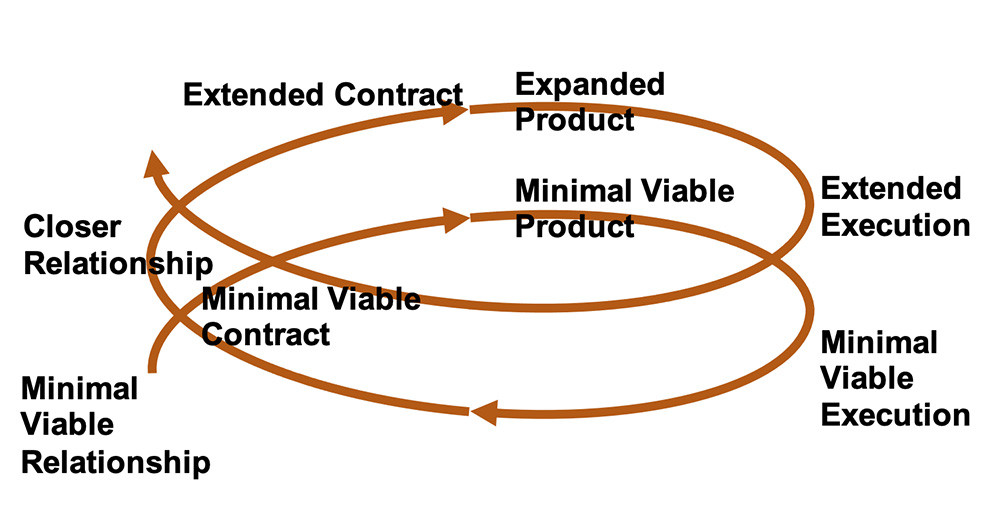Contract Management Collaboration – success in 4 steps
“Contract Management Collaboration – success in 4 steps” is the third in a series of articles on supplier-client relationships, triggered by the coronavirus (COVID-19) and the economic downturn. Our recommendations hold true well beyond both of those challenges.
The first article captured the risks of short-term responses to economic pressures and advocates seeking collaboration instead of conflict in commercial relationships. Its strongest approach is to think of the other party first, respond to their objectives and generate the outcomes all parties need for most instances.
The second article reflected the fundamentals for collaborative relationships. Its main message: get basics right, model and implement operations in line with nine guiding principles of collaboration.
What follows describes how 9 principles of collaboration fit into one cohesive lifecycle and are reflected within four steps to deploy best practices in collaboration. We have tested these in real life work scenarios.
Achieve Contract Management Collaboration success in 4 steps:
- Align mutual interests and objectives.
- Understand drivers and requirements for collaboration.
- Decide on a collaboration model.
- Develop and deploy a collaboration roadmap.
1. Align mutual interests and objectives
The first and second principle help you understand how mutual interests and objectives organize and align to match a situation. It’s all about attitude and specifically aligning objectives of all parties.
To do this, why not host an internal reflection session followed by workshop(s) with the other party. Make sure that you have a rough idea on your own interests and objectives. But first, focus primarily on what the other party wants to achieve. Then return to your own needs, and balance them with the assumed needs of the other party.
If you are the customer make this step part of the preparation for a full sourcing program. After each side has prepared itself, convene in a workshop with both parties, to understand the interests of each side.
Your process from understanding to alignment is a deliberate progression. You may do this in the same workshop if mutual understanding seems good. Otherwise allow some time for parties to reflect and then reconvene. Then find out whether parties interests and objectives are aligned. Are they complementary or conflicting?
Interests are usually fixed, but objectives often can be adapted to create a better fit with those of the other party. For example, when re-contracting IT-outsourcing, the customer’s interest could be to assure continuity of its business supported by a controllable level of spend. This could be originally translated into a straight 20% cost-cutting objective, but it would probably conflict with the supplier’s interests and objectives. Parties that understand each other’s needs and objectives could instead jointly look for alternative approaches, such as usage-dependent pricing or alternative revenue sources for suppliers that offset a 20% cut of the original outsourcing budget.
Revisit interests and objectives on a regular basis. Check to what extent each parties’ interests are served and objectives are met. Also check the crossover; if you care about the interests of the other party first, is that behavior mirrored by them? And how about the benefits for each individual? Monitor the process to see if both sides achieve their objectives. Use the results to support reviews with both parties.
2. Understand drivers and requirements for collaboration
This reflects the third and fourth principles describing differences between parties working together:
- Differences generate value: seek and exploit complementary capabilities.
- Differences carry risk too: accommodate resistance against leveraging the other party’s capabilities.
Differences in the capabilities and footprint synergies are the reason why you need to collaborate. They drive the actual services or products in which the parties complement each other. Address these differences with respect to capabilities, culture and style so you can leverage those differences as the key enablers of effective collaboration. Seek and exploit complementary capabilities and synergies.
First, ask specifically:
- What is the outstanding strength of the other party that you want take advantage of?
- Which of their capabilities are really needed and lacking in your organization?
- And how do these questions play out the other way around from the perspective of the other party?
Then take action:
- Run a structured due-diligence process to find out the answers.
- Contract delivery that focuses on those capabilities, and translate those into actual focused services or products.
Mitigate the risk of differences that could potentially cause trouble. When you face resistance against leveraging capabilities of the other party, accommodate any rational objections and address emotional issues.
Better still, stay ahead of trouble:
- Run workshops to raise the awareness of cultural and personal style differences in both organizations.
- Do a scan early on, to find differences between parties that might threaten the collaboration. Typical threats are in the cultures you might be working with. Examples include small, young startups versus large established enterprises, or continental European customer organizations versus offshore Asian service providers.
Risky differences can also be on the structural side. The way the organization, business and IT processes, or management systems of both organizations are structured can be so different that it is very hard to work together. Overall, don’t try to remove all differences. After all, you’re working together because you are different. Respect that.
Other factors drive the type of collaboration aside from the ones explained above. The nature of the actual products or services being delivered significantly impacts the requirements for collaboration as well.
For instance, when buying or selling a commodity product, you don’t need an intimate collaboration. On the other hand, if you are betting your company on the development of a high-risk visionary information system, you’d better have a solid, transparent and trusted relationship with the IT-company creating it. We recommend understanding the nature of services or products to be delivered, determining their collaboration requirements, and organizing the collaboration accordingly.
Contract Management Collaboration – success in 4 steps: Step 3. Decide on a collaboration model
We have developed a framework to guide your selection of a collaboration model. This consists of a set of guidelines, frameworks and reference models for developing relationships between collaborating parties in ecosystems.

One of the collaboration principles is to choose the relationship type to match the situation. At a high level, that choice is driven by the aligned objectives, the differences between them, and the nature of services or products, as discussed above. Three aspects of collaborative relationships are worth explaining in more detail:
- Developing trust,
- Collaborating as enemies, and
- Partnership is not a customer/supplier relationship model.
Developing Trust
Trust is a tricky topic, because of the challenge to make it specific and concrete. On the internet, countless publications on trust are just a click away, but for our purpose a few practical guidelines should be enough.
- First, raise the level of awareness.
- Ensure stakeholders in your organization understand that the level of required trust depends on the nature of the service or product being delivered.
- Distribute a few relevant publications, run a workshop on trust, using real life examples to discuss what trust is, what builds and destroys it, and what different trust levels one could distinguish.
- Second, do a trust due diligence.
- Assess the required trust level. Focus on behavior versus risk. This is about required predictability of desired behavior by organizations and individuals and the consequences of unwanted behavior. For example:
- Will the other party deliver on time, on budget and with the required quality level?
- What are the consequences if the other party fails?
- Will the other party behave in your interest when things go wrong?
- For the supplier: will the customer pay on time, without hassle? If things go wrong: what will the damage be?
- Now, how does the other party score on trust?
- You may want to use the NACCHO tool for assessing the required trust level and scoring actual collaboration parties.
- A caveat: make sure that the person you are dealing with has the backing of his or her organization. You don’t want personal commitments to end up being nothing more than talk.
- Third, match it up.
Make sure the expected trust levels are sufficient for the collaboration. If trust is too weak, try to boost trust levels, e.g. through gaining stronger sponsorship. It may take some time to deliver the required level. The alternative is to either seek another party or re-scope the contract so that it fits the actual trust level. - Fourth and finally, monitor and develop.
Trust is not a fixed once-and-for-all agreed, mutual attitude. It needs ongoing attention and effort. We recommend monitoring trust levels regularly with all other aspects of the collaboration.
Collaborating as enemies (adversaries)
Not everyone is your friend; a close relationship is not always needed nor feasible for each collaboration. Chose the kind of collaboration that fits the nature and attitude of contracting parties, then move forward to collaborate as enemies — if that is appropriate.
For many people the idea of working together as “enemies” sounds absurd but it isn’t so. Although in many industries it is customary to pretend that close and trusted relationships are the holy grail to strive for, the reality is that some relationships are more adverse by nature. When interests or objectives are conflicting between parties, without an alternative for collaboration, parties are forced to work together. Examples may include competitors forced into collaboration by rule-of-law, or customers in a vendor lock-in situation with monopolistic software suppliers that seek to maximize revenue and profit at all cost.
So, be prepared for adverse relationships. For every significant business relationship, conduct an analysis that includes the power balance, mutual dependencies and balance of interests and objectives. If this indicates that an adversarial relationship seems the most realistic option, don’t shy away from it. Rather organize yourself to best deal with it.
For starters, have adequate legal support in place, and tough negotiators for contracting and manage delivery in a controlled way.
Partnership is not a customer/supplier relationship model
Don’t blur the commercial customer/supplier relationship model that is inherently competitive with the friendly connotations of real partnerships built on shared interests and objectives.
Partnerships are not a true option for all commercial relationships, because shared interests, objectives and other conditions for partnering are usually lacking. If you think about your commercial relationship as a partnership, think again. If it meets the criteria for true partnership, call it a partnership and operate it as such. Otherwise, don’t, and make sure you deal with the potential tension and friction that may come with differing interests or objectives.
Contract Management Collaboration – success in 4 stepsStep 4. Develop and deploy a collaboration roadmap
Charting a roadmap starts with establishing where you are and agreeing where you are going. Do establish the as-is situation and build from there. The roadmap is all about developing the ingredients for effective collaboration. This road takes us through trusting, knowing each other, being willing to invest, delivering mutual results, as well as resolving the hard-structural components such as organization, business and governance processes.
In applying agile principles, we promote parties going through the development process together, and iteratively. Allow the time for change and adopt a structured process to develop the collaborative relationship all parties are seeking. Also, doing this together will build the relationship itself.
As parties experience over time that the other side lives up to expectations, trust and ability to work together will grow. This creates opportunities to engage in more complex and risky engagements, which in turn provide a platform for further development of trust and deeper collaboration. Thus, parties get into a virtuous collaboration spiral leading to ever more ambitious engagements that deliver value for both parties — starting with smaller elements of scope for deeper collaboration while allowing other services to be delivered in a more traditional way.
Sourcing starts with understanding the minimal relationship that is viable (capable of working successfully) between parties, considering the actual level of trust and their collaboration competencies. This is the opposite of parties that barely know each other and yet promise each other a partnership.
The agile sourcing approach is the opposite of the traditional sourcing practice replacing long negotiating cycles and late inflexible contracts and delivery. Key components are a Minimal Viable Relationship (MVR) and a Minimal Viable Contract (MVC).

The MVR defines a level of service or product delivery that should be feasible. That means it is probably not too complex and is low risk. This is the opposite of the accepted practice in many industries specifically overcommitting and underdelivering.
As a result, parties get into a business relationship at a level of performance where expectations are low but will be met. This builds trust and allows more complex and risky engagement contracted and delivered – which, as
Encourage collaboration to match changing conditions!
As explained at the end of our second article, collaboration is configurable, and must be tailored to meet the needs and possibilities of the situation. It is also true that those circumstances change over time, as the collaboration itself. Allow the collaboration a development perspective. Give it room to dynamically match the requirements and opportunity of the situation over time.
We hope that the series of three articles gives some useful guidance how to design and deploy relationship-based collaboration.








